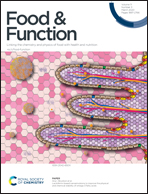Glycyrrhizin inhibits osteoarthritis development through suppressing the PI3K/AKT/NF-κB signaling pathway in vivo and in vitro†
Abstract
Osteoarthritis (OA) is a serious and frequently occurring disease in the elderly, characterized by cartilage degeneration and proliferation of bone structure. Glycyrrhizin, a compound extracted from licorice, has been reported to have various important biological activities, such as antioxidant properties and anti-inflammatory action. However, it has not been reported whether glycyrrhizin has a positive effect on OA development. Our study aimed to evaluate the effects of glycyrrhizin on human OA chondrocytes. In the present study, we discovered that glycyrrhizin remarkably suppressed the interleukin (IL)-1β-induced level of nitric oxide (NO), prostaglandin E2 (PGE2), tumor necrosis factor alpha (TNF-α) and interleukin-6 (IL-6) and the production of cyclooxygenase-2 (COX-2), inducible nitric oxide synthase (iNOs), metalloproteinase3 (MMP3), metalloproteinase13 (MMP13) and a disintegrin and metalloproteinase with thrombospondin motifs5 (ADAMTS5). In addition, glycyrrhizin inverted the degradation of aggrecan and collagen II. Moreover, it significantly inhibited IL-1β-stimulated PI3K/AKT phosphorylation and NF-κB mobilization in human OA chondrocytes. In vivo, glycyrrhizin treatment prevented the destruction of cartilage in mice OA models. In summary, all the results demonstrate that glycyrrhizin may be a potential therapeutic approach for OA.



 Please wait while we load your content...
Please wait while we load your content...